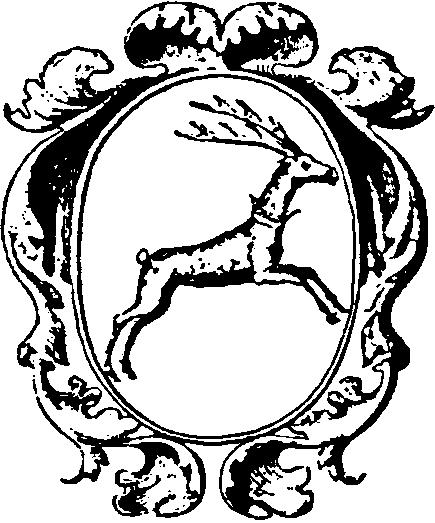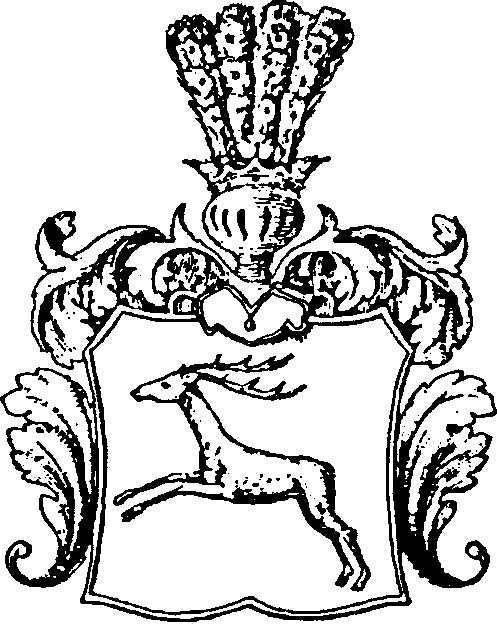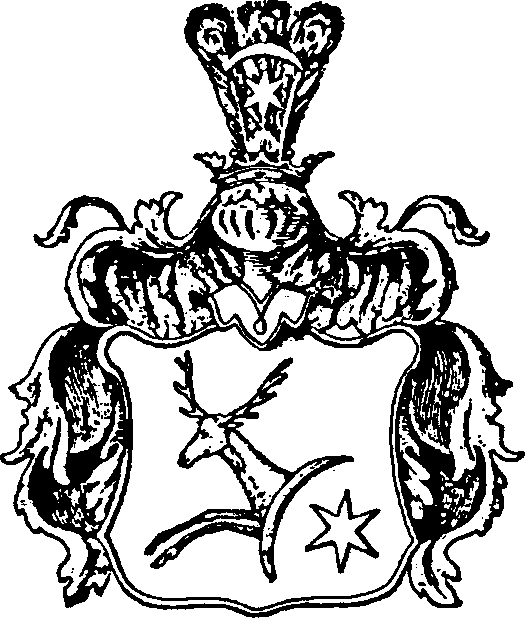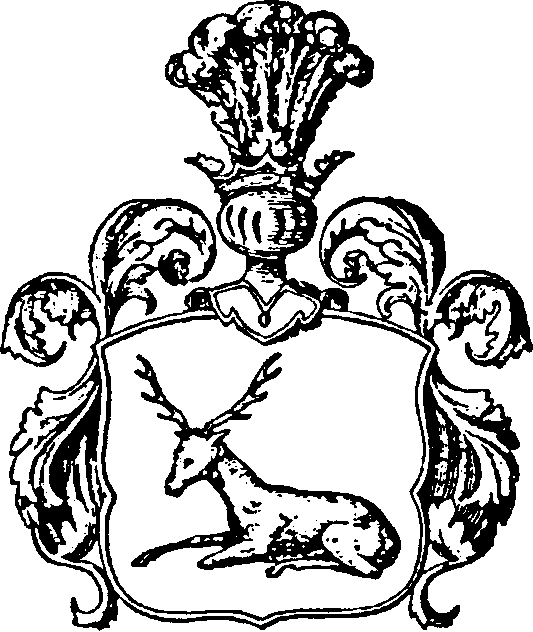Herb Brochwicz
Research Heraldry Herb Brochwicz
Herbarz Polski translation
Brochwicz herb
 The following is a direct translation from the classical genealogical and heraldic reference "Herbarz Polski" by Kasper Niesiecki, S. J., Lipsk edition, 1839-1846.
The following is a direct translation from the classical genealogical and heraldic reference "Herbarz Polski" by Kasper Niesiecki, S. J., Lipsk edition, 1839-1846.
According to Okolski's description there is a red stag on a white field with forelegs raised as if for swift chase after driven animals; a crown is on its neck, and on the helm are peacock feathers. But in a book on Polish emblems I read that it should be a white stag in a red field. Lublin province uses such arms; but Petrasancta cap. 54 is a witness that in Britain, France, Italy, and Germany there flourish a great many houses who sport a stag in their arms. No one gives these arms an occasion; only Okolski adds that they were brought to Poland from Germany. I have not read what families use the arms in their seals, only of the Sobeks of Sulejów, of whom I will speak in the proper place.
Copyright © 1991 William F. Hoffman. Used by permission. This article originally appeared in Polish Genealogical Society Newsletter (Vol. XIV, No. 1, Spring 1991), the bulletin of the Polish Genealogical Society.
Brochwicz 2do herb
 The following is a direct translation from the classical genealogical and heraldic reference "Herbarz Polski" by Kasper Niesiecki, S. J., Lipsk edition, 1839-1846.
The following is a direct translation from the classical genealogical and heraldic reference "Herbarz Polski" by Kasper Niesiecki, S. J., Lipsk edition, 1839-1846.
A stag facing the right of the shield, without a crown on its neck. Our Ks. Petrasancta cap. 63 mentions that in Franconia the arms of the house of Hirschberk bear a stag on a silver shield; and the Duchy of Lorraine in ancient times used a stag with golden horns.
Bearers of these Arms
Bryszkowski, Burgrafski, Dobrocieski, Dubaniewski, Goisowski, Grabanowie, Katski, Korczyc, Orzelski, Palipcki, Podkanski, Polomski, Pruszkowski, Szalowski, Trembecki, Wiktor, Witowski, Wojakowski, Zielenski
Copyright © 1991 William F. Hoffman. Used by permission. This article originally appeared in Polish Genealogical Society Newsletter (Vol. XIV, No. 1, Spring 1991), the bulletin of the Polish Genealogical Society.
Brochwicz 3tio herb
 The following is a direct translation from the classical genealogical and heraldic reference "Herbarz Polski" by Kasper Niesiecki, S. J., Lipsk edition, 1839-1846.
The following is a direct translation from the classical genealogical and heraldic reference "Herbarz Polski" by Kasper Niesiecki, S. J., Lipsk edition, 1839-1846.
Neither Paprocki nor Okolski wrote about these arms. There is half a golden stag with horns and forelegs running or jumping on the right side on a field of gold; in place of the stag's hindquarters is a moon, not fun but more like a new moon, slanted, in the middle of which is a golden star. On the helm are peacock feathers, on which are a moon and star as on the arms themselves. I saw a coat of arms as described on a banner, hung in the Franciscan Fathers' Church in Krosno, of Joachim z Kralic Slaski, who died in 1606. The same can be seen to this day among the other arms of Regina z Kralic Oswiecimowa, mother of Stanislaw 0swiecim, founder of the 0swiecim chapel, in Krosno at the Franciscan Fathers'. Petrasancta does not have similar arms, only cap. 54 fol. 367. He describes the Maffeiuses in Rome thus, that there is a stag jumping from an azure field, but as regards the moon and star, his description is of gold and silver ones. These arms seem to be more like those of Tomasz Bacotz de Erdead, Cardinal and Archbishop of Strygon, portrayed in the chapel of the Strygon palace magnificently erected by him. Cerut. Orbis fol. 57 Reufr. lib. 14 epistol. fol 115, that is, a stag which is jumping to the right from a semi-circle or from a half-wheel, a red field, the stag and wheel silver or white. I understand from this that these are arms of the Slaskis, inasmuch as they settled in Podgórze near Hungary, and so they were brought from there to us. As regards the moon, it could be that arose by error, that the semicircle was misunderstood to be a nonfull moon, and a hub of the wheel was interpreted as a star. These same arms are those of the Palfiuses de Erdead in Hungary, a horned stag jumping forth from a hub, as I saw in a certain panegyric in Vienna published by Paulo Palfi, imperial counselor in 1646. Among us in Poland I have not seen any other houses use these except the Slaskis.
Copyright © 1991 William F. Hoffman. Used by permission. This article originally appeared in Polish Genealogical Society Newsletter (Vol. XIV, No. 1, Spring 1991), the bulletin of the Polish Genealogical Society.
Brochwicz 4to herb
 The following is a direct translation from the classical genealogical and heraldic reference "Herbarz Polski" by Kasper Niesiecki, S. J., Lipsk edition, 1839-1846.
The following is a direct translation from the classical genealogical and heraldic reference "Herbarz Polski" by Kasper Niesiecki, S. J., Lipsk edition, 1839-1846.
Neither Paprocki nor Okolski wrote of these arms. A stag of its own color on a red field, its head facing the right, as if lying down, but its foreleg a little raised and the other legs still folded, and on the helm and crown are five white ostrich feathers. These arms were brought from England to Poland, and there is proof of this; for our Ks. Petrasancta cap. 54 fol. 365 affirms that the Hartulliuses in the Kingdom of Great Britain use such a stag as is here described, only on a silver shield. Here in Poland the Destrahans use this emblem, of which you will read in the proper place.
Copyright © 1991 William F. Hoffman. Used by permission. This article originally appeared in Polish Genealogical Society Newsletter (Vol. XIV, No. 1, Spring 1991), the bulletin of the Polish Genealogical Society.
;
